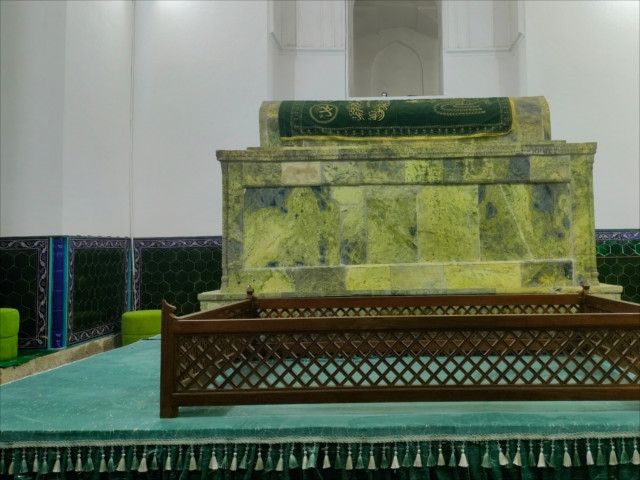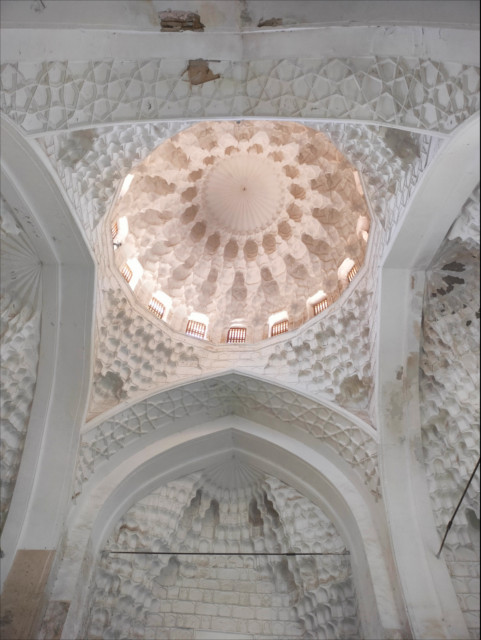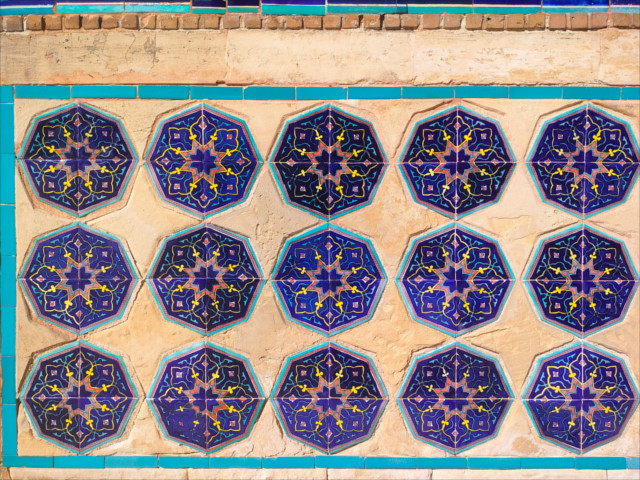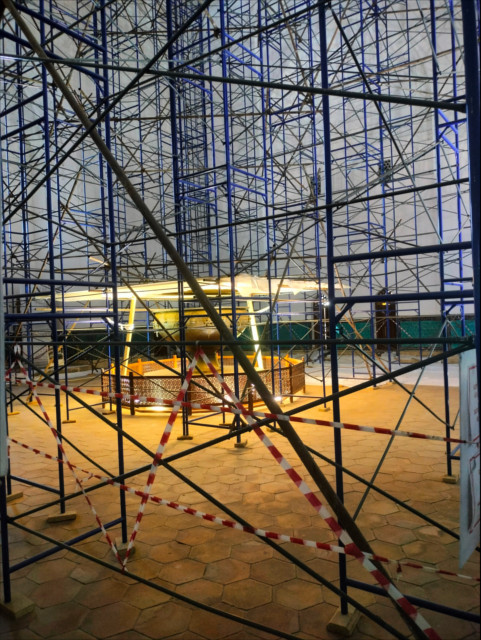Khoja Ahmed Yasawi (1093-1166 CE) is a name to remember. He was a mystic, the first poet to write in Khaqani Turkic, the language of the silk route (speakers of modern Hindi will recognize one word in five), and the founder of a Turkic Sufi order called the Yeseviye which strongly influenced the Islam of Central Asia. In 1389 his mausoleum in Yasi (currently called Turkestan) was ordered to be rebuilt by Timur. Yasawi was born in the nearby silk route town of Sayram, now a suburb of Shymkent, and his family’s tombs are scattered across a few streets in that town. He moved to Bukhara, rose to prominence and moved back to Yasi to preach.


When we walked up to the mausoleum it was immediately apparent that it was unfinished: the immense arch over the entrance had no mosaic work on it. But that was interesting in itself, as the citation in the UNESCO World Heritage listing points out. We could see that the structure was made from bricks of fired clay. Far above us, construction beams were visible: each was the trunk of a tree. It is said that Timur was obsessed with this structure and took part in its design. The work was abandoned for lack of funds on Timur’s death in 1405. We found that you could not enter the structure from the front.


So we walked around to the back and gasped at the beautiful tile work on the facade. We admired the tile encrusted Thuluth style callgraphy across the top of the facade. If our guide Devlet hadn’t mentioned it, I wouldn’t have noticed that the repeating tile work all across the facade just says “allah” over and over again in Khufik script. The structure with its thirty five rooms functioned as a khanaqah, and contained both a mosque and the mausoleum. We first entered the mosque (see the detail of the mihrab in the photo above), and then went round to see the grave of the poet-preacher. This was crowded and I could only get a restricted view of the jade covered sarcophagus. The ribbed dome that you can see in the featured photo lies directly above it.


The architecture of Yasawi’s mausoleum was innovative. It was later copied across Central Asia and become the style which is today known as Timurid. It is said that Timur himself took part in the planning of this structure. Whether or not you believe that, Timur was interested enough in the progress of the construction that he returned fairly often to Yasi. Even though Samakand, Bukhara, and Tashkent have better known Timurid structures, this one is preserved much better, and, being unfinished, let us in behind the curtains to see how it was made. It was also interesting to see features like the alabaster muqarnas (stalactites) adorning the vaults above us, and the profusion of tiles inside. It is said that Timur brought mosaic workers from Shiraz and tile workers from Isfahan to participate in the building of this mosque. We had assumed that centuries later the making of blue glazed tiles would be a local handicraft, but it wasn’t.

The kazandyq, the main hall, was closed off for repairs. This lies under the primary dome: with its diameter of 18.2 meters, it is the largest brick dome in Central Asia. Even now it is an architectural marvel. In the 15th century it must have seemed miraculous. This room had a large bronze cauldron. Devlet told us that it had been taken for an exhibition to St. Petersburg, then Leningrad, and had not been returned for decades. It was only in the years of Perestroika that it was returned. It was a pity that I couldn’t get closer to it. But there was more to see around the grand structure.

If I read this correctly, this beautiful structure honors the memory of a poet/mystic/religious leader. His influence must have been profound.
LikeLiked by 2 people
Yes. His Sufi teachings influenced the version of Islam practiced across Central Asia. Another measure of the influence is that there is an international airport that serves Turkestan (formerly Yasi) and connects to Saudi Arabia, Istanbul, Antalya, and Dubai (and to much of Asia and Africa through Istanbul and Dubai).
LikeLiked by 2 people
Remarkable.
LikeLiked by 2 people
Thank you for this post. It is so interesting to learn of origins. Part of the Alhambra has a similar ‘stalactite’ dome.
LikeLiked by 2 people
Yes, they are roughly contemporary. So it’s not surprising. The world was pretty “globalized” then, although over Asia, Africa, and Europe only.
LikeLiked by 2 people
Fascinating.
LikeLiked by 2 people
Isn’t it!
LikeLiked by 2 people
Wow! What an impressive structure inside and out! Thanks for the history and beautiful photos.
LikeLiked by 2 people
Glad you liked it
LikeLiked by 2 people
Indeed, an opportunity to see where some amazing architecture came from.
LikeLiked by 2 people
Thank you
LikeLiked by 2 people
What a beauty! Your photography does it justice and your commentary was great.
LikeLiked by 2 people
Thank you.Glad you liked it
LikeLiked by 2 people
Such a great architecture… and the details!
LikeLiked by 2 people
Glad you enjoyed it.
LikeLiked by 2 people
Thank you for this post, the photos and explanation. This is a magnificent structure I would never know about without this post. Seeing buildings like this, even unfinished, I just have to wonder at the planning and craftsmanship involved. Just the logistics of finding supplies and workers would have taken an enormous effort.
LikeLiked by 2 people
Glad to bring something different. Timur had a large empire, and he brought together artisans from across it for this structure: Iran, Russia, China, India.
LikeLiked by 2 people
What a structure! And what an architect. Unknown to me,and I suspect to many in Europe.
LikeLiked by 2 people
Europe forgot much in the 19th century.
LikeLiked by 2 people
And still does …
LikeLiked by 1 person